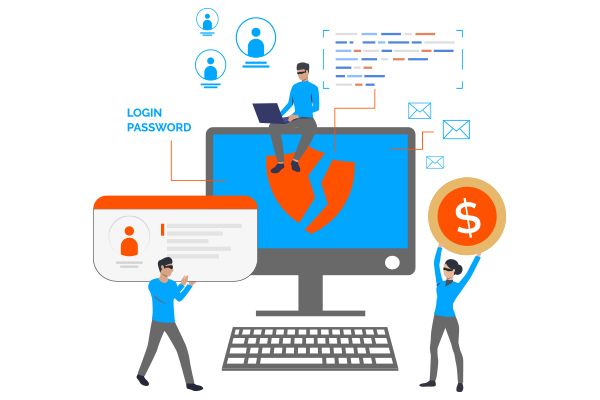
If you work in an organization where all the computers are connected to a local network, the in
formation that goes out of and into that network stays highly insecure provided that no network or file level security has been duly implemented on it. In this technology age, when more or less everything has gone digital while technology has been advancing at a rather faster pace, most of the organizations have adopted network based computing system to carry out a safe communication with their clients and to keep record of all the data being sent to and received from one place to another.
When a huge volume of sensitive corporate information is being transferred into and out of the network, there is always a chance that some bad internet guys manage to break into your networks and steal your information or damage your systems.
To fend off all these data security threats and expected external attacks, a complete data security system must be established to secure the network against all type of malicious content, unauthorized intruders as well as against the lost or leakage of your private and confidential data. Or at the very least, a reliable and strong file and folder encryption software should be installed and used to have your data secured from unauthorized access.
For a quick and effective action to protect your files and folder, a reliable and fast computer data security application should be used that is capable of alerting you whenever someone tries to make unauthorized access to your files.
Computer systems are being used in every walk of life ranging from studying to banking, from investing to shopping and communicating among groups and individuals. For this reason, the need of securing and keeping all your personal and private information secure arises so that it will not get into wrong hands.
There are some bad guys whom we called hackers, crackers or intruders, who do not bother about the laws, and are constantly in the quest of finding out new ways to hack into your computer so that they can gain control of your computer to launch attacks on the entire network. This is usually done by infecting a computer or the network with a malicious program which can be a virus, malware, adware or any other malicious coding.
The only possible way to prevent data leakage because of any such breaches in security is to make sure that your data is protected with effective and industry reliable file encryption software. This is because only file encryption software can protect your files from getting accessed by unauthorized users.
You can prevent hacking attempts by disconnecting the computer from the network when it is not in use. However, this will not prevent offline threats to your data, for instance someone from your organization may try to steal your valuable information while you are away. So the wise solution is to protect your data with an industry reliable encryption program.
What Is Computer Data Leakage?

Computer data leakage is the unauthorized transfer of sensitive data from a computer system, either intentionally or unintentionally. Data leakage can occur through a number of different mechanisms, including malware, hacking, and accidental data loss. In some cases, data leakage can be used for malicious purposes, such as stealing confidential information or gaining access to restricted systems.
Preventive Measures To Avoid Data Leakage
Data leakage can be prevented by implementing the following measures:
1. Implementing user access controls and authentication methods such as passwords and two-factor authentication.
2. Encrypting data and using secure protocols for data transmission.
3. Regularly backing up data and monitoring systems for suspicious activity.
4. Educating employees on data security and privacy best practices.
5. Performing regular security audits and vulnerability scans.
6. Limiting access to sensitive data to only those who need it.
7. Implementing data loss prevention (DLP) solutions.
8. Using secure web applications and firewalls.
Data Loss Prevention In Security
Data Loss Prevention (DLP) is a security measure that is designed to protect sensitive data from unauthorized access, use, or disclosure. It is a set of tools and processes that are used to detect, prevent, and respond to potential data loss incidents. DLP typically involves identifying and classifying sensitive data, monitoring for potential data leakage, and implementing measures to prevent data leakage. These measures can include encryption, access control, data masking, and application-level security measures such as web application firewalls.
Best Ways To Prevent Data Leakage
Data leakage can be prevented by using a variety of techniques. These include:
1. Encryption: Encryption is a process by which data is converted into a code, making it unreadable without a key. This prevents unauthorized access or modification of the data.
2. Access Control: Access control is a process of restricting access to data based on user roles and permissions. This helps to prevent unauthorized access or modification of data.
Computer Security Prevent Spillage
Computer security can prevent data spillage by implementing various measures such as:
1. Firewalls: Firewalls are used to protect networks from malicious activities by blocking unauthorized access.
2. Encryption: Encryption is used to protect data from unauthorized access by encoding it so that only authorized users can access it.
3. Access Control: Access control is used to restrict access to data based on user roles and permissions. This helps to prevent unauthorized access or modification of data.
Defining Spillage In Computer Security
Spillage in computer security is a type of data leak which occurs when sensitive data is exposed to unauthorized individuals or organizations. This type of data leak can occur due to malicious attacks, negligence, or accidental exposure. To prevent spillage, organizations should implement robust security measures such as encryption, access control, and firewalls.
Top Measures That Help To Reduce Risk Of Data Leakage
1. Implementing strong encryption
2. Using access control measures
3. Installing firewalls
4. Regularly auditing system security
5. Educating users on data security
All of the above measures can help reduce the risk of data leakage. Encryption helps protect data from unauthorized access, while access control measures limit who can access sensitive data. Firewalls can be used to prevent malicious attacks and unauthorized access. Regularly auditing system security can help identify
Causes Of Data Leakage
Data leakage can be caused by a variety of factors, including human error, malicious attacks, and system vulnerabilities. Human error can occur when users do not follow security protocols or when they accidentally or intentionally share confidential information. Malicious attacks can occur when attackers gain unauthorized access to a system and steal sensitive data. System vulnerabilities can occur when software or hardware is not properly configured or updated, leaving the system exposed to attack.
Importance Of Data Leakage
Data leakage is important because it can have serious implications for organizations. Data leakage can lead to the loss of confidential information, financial losses, legal liabilities, and reputational damage. It can also lead to the disruption of services, the theft of intellectual property, and the loss of customer trust. Data leakage can also lead to an increased risk of cyber attacks, which can have devastating consequences for organizations. As such, it is important for organizations to take steps to prevent data leakage and protect their
Introduction To Computer Data Leakage
Computer data leakage is the unauthorized transfer or disclosure of confidential or sensitive data stored on a computer system. Data leakage can occur when a user accesses or transmits data without authorization, when a user fails to secure data, or when a user shares data with unauthorized users. Data leakage can be intentional or unintentional. Intentional data leakage can occur when a user deliberately shares confidential information with unauthorized users, while unintentional data leakage can occur when a user fails to secure his or her data and it
Types Of Data Leakage
The types of data leakage can generally be divided into two categories: active and passive.
Active data leakage involves the intentional and unauthorized transmission of data, either through malicious activities or through the use of unauthorized software or hardware. Examples of active data leakage include hacking, phishing, malware, and the use of unsecured networks.
Passive data leakage occurs when data is unintentionally exposed or leaked. Examples of passive data leakage include data stored on unsecured networks.
Example Of Data Leakage
An example of data leakage is when an employee sends sensitive company data via email to an unauthorized recipient.
Function Of Leakage
Leakage function is a mathematical model used to describe the flow of data from a system. It is used to measure the amount of data that is lost or leaked from the system. The leakage function is used to determine the security of a system and to identify potential vulnerabilities.
Ways Of Data Leakage
Data leakage can occur in a variety of ways, including:
– Unsecured databases or networks
– Unencrypted data transmission
– Unauthorized access to data
– Poorly configured access controls
– Unauthorized physical access to data
– Malware or malicious code
– Human error or negligence
Data Leakage A Security Threat
Yes, data leakage is a security threat. Data leakage can lead to unauthorized access to sensitive information, which can be used for malicious purposes such as identity theft, fraud, or other malicious activities. Data leakage can also result in financial or reputational damage to an organization or individual. As such, organizations should take steps to ensure that their data is protected and secure.
What Is A Data Leak Called?
A data leak is commonly referred to as a data breach.
Types Of Data Loss Prevention
1. Network-based Data Loss Prevention (DLP): This type of DLP focuses on monitoring and controlling network traffic, such as emails, web traffic, and file transfers.
2. Host-based Data Loss Prevention (DLP): This type of DLP focuses on monitoring and controlling data stored on individual systems.
3. Endpoint Data Loss Prevention (DLP): This type of DLP focuses on monitoring and controlling data stored on endpoint devices such as laptops, desktops,
Best Methods Of Loss Prevention
1. Employee Training and Education: This is a key component to any loss prevention strategy. Educating employees on the importance of security and the potential risks of data loss can help to reduce the risk of data theft.
2. Physical Security Measures: Physical security measures such as locks, alarms, and surveillance systems can help to prevent unauthorized access to data.
3. Access Controls: Access controls such as passwords, biometric authentication, and two-factor authentication can help to ensure that only authorized
Levels Of Data Security
1. Confidentiality: This level of data security ensures that only authorized individuals can access sensitive data.
2. Integrity: This level of data security ensures that data is not altered or corrupted in an unauthorized manner.
3. Availability: This level of data security ensures that data is available to authorized individuals when needed.
4. Non-Repudiation: This level of data security ensures that data cannot be denied or repudiated by the sender or receiver.
